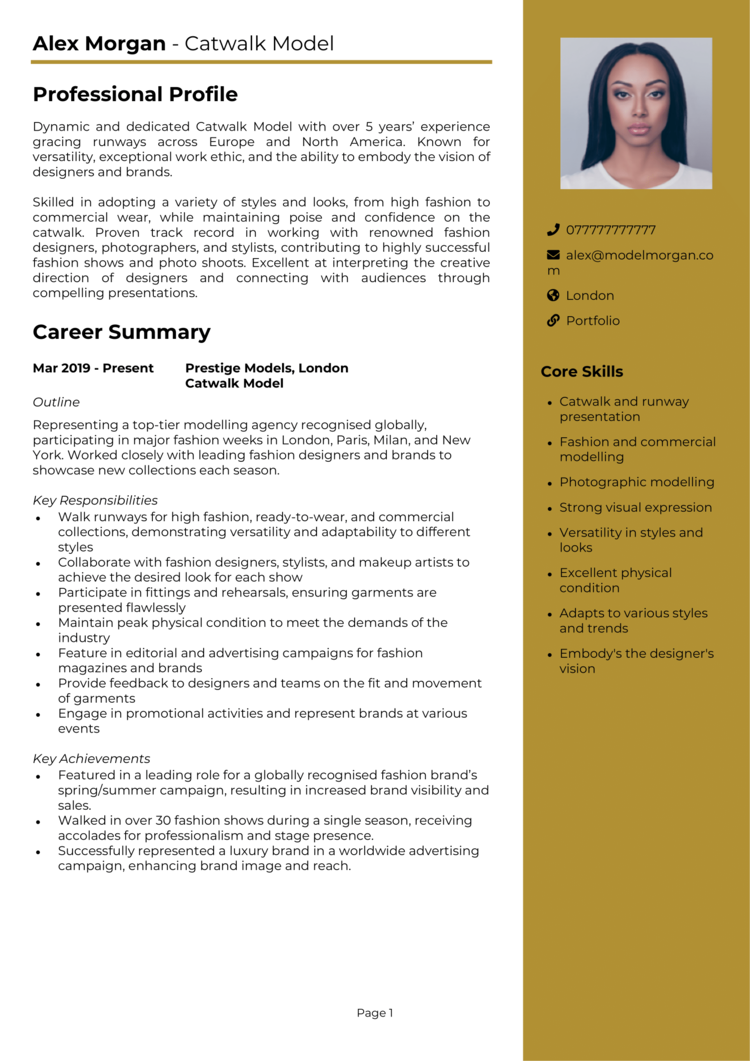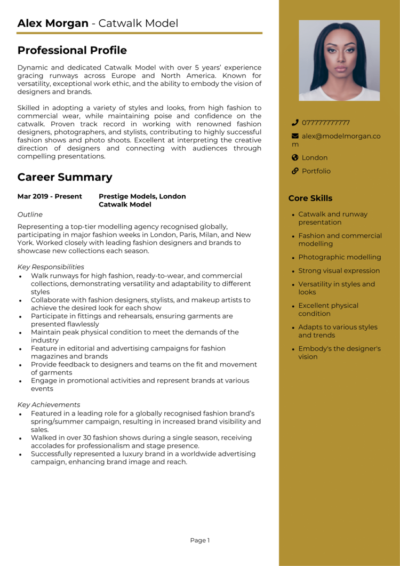Do you have the poise and confidence to light up runways or bring campaigns to life?
As a model, your CV needs to do more than list your experience – it has to convey your versatility and potential to get your foot (or boot) in the door. Think of it like your personal highlight reel. If it doesn’t dazzle the recruiter, they might just scroll past you like a mediocre Instagram post.
This guide, complete with a Model CV example, will show you how to craft a CV that highlights your unique qualities and lands you those casting calls.
Modelling CV example

How to write your Model CV
Learn how to create your own interview-winning Model CV with this simple step-by-step guide.
A Model CV isn’t just about listing jobs – it’s a reflection of your brand. It needs to highlight your experience, adaptability, and the key qualities that make you a standout choice for campaigns or agencies.
This guide will help you write a CV that complements your portfolio, showcasing your achievements and ensuring you’re noticed by casting directors.
Structuring your Model CV


Your CV structure should be as polished and professional as you are on the runway. Think of it as the behind-the-scenes prep that makes the show flawless.
Here’s how to structure your Model CV:
- Name and contact details – Have these personal details at the top so agencies can contact you easily. Including a photo is always optional, but strongly recommended for this role, for obvious reasons.
- Profile – Begin with a concise summary that highlights your expertise and career goals, and what you bring to the role.
- Core skills – State your best qualities at a quick glance, with a column or two of bullet points.
- Work experience – Start with your most recent role and work backwards, showcasing achievements and responsibilities.
- Education – Highlight your achievements and training that demonstrate your expertise.
- Additional info – You can add hobbies and interests or activities here that reflect your enthusiasm for the role and industry.
Model CV format


Your CV’s format should be clear and perfected, like your campaign-ready portfolio. Even the best experience can be overlooked if your CV looks rushed or disorganised.
First impressions matter in modelling – don’t let formatting mistakes distract from your experience and talent.
Here’s how to format your Model CV:
- Bullet points – Break up dense text to make it easier to skim.
- Divide sections – Break your CV into distinct sections with clear headings for smooth navigation.
- Use a clean font – Choose a simple, professional font to keep the layout sleek.
- Keep it the right length – Aim for no more than 2 pages. This gives you space to detail your experience while keeping it concise enough to keep the recruiter’s interest.
What is a Model CV profile?


Your CV profile is the opening look of your CV. Make it strong enough to turn heads and leave recruiters wanting to see more. Highlight your modelling experience, unique features, and what sets you apart.
Model CV profile examples
Profile 1
Versatile Model with five years of experience in fashion runway shows, editorial photoshoots, and brand campaigns. Skilled in posing, maintaining brand aesthetics, and adapting to diverse styles and creative directions. Experienced in collaborating with top designers and photographers.
Profile 2
Dedicated Commercial Model with three years of experience in advertising campaigns and lifestyle photography. Proficient in portraying relatable characters for TV and online commercials. Known for professionalism on set and ability to connect with diverse audiences.
Profile 3
Experienced Freelance Model with over seven years in the beauty and cosmetics industry, specialising in product shoots, influencer collaborations, and promotional events. Skilled in maintaining brand consistency and working under tight deadlines.
What to include in your Model CV profile
Here are some tips on what to include in your Model profile:
- Where you’ve worked – Name the sorts of agencies, campaigns, or brands you’ve worked with and for how long.
- Your top features – List off some of your key attributes, such as measurements or special skills like dance.
- Essential modelling skills – Note important abilities of yours, like runway walking or working with photographers.
- Specialised areas – Reference areas like commercial, editorial, or fitness modelling.
- Career aspirations – Briefly mention what you’re aiming for in your career, whether it’s high fashion or print campaigns.
Core skills section


Your core skills section gives recruiters a quick look at your abilities. For models, it’s the perfect place to highlight technical and creative strengths.
Tailor your core skills to the gig. A runway model and a commercial model won’t list the same strengths, just like you wouldn’t wear six-inch stilettos to a beach shoot.
Struggling to put together a professional model CV?
Try our CV builder – it helps you create a sleek and polished application with tailored content, stylish templates, and expert tips.
Top skills for your Model CV
- Runway Modelling – Mastery of walking techniques and stage presence.
- Editorial Posing – Versatility in posing for fashion shoots and creative campaigns.
- Commercial Modelling – Experience working on TV, print, or product advertising.
- Fitness Modelling – Expertise in shoots focused on athleticism and wellness.
- Wardrobe Adaptability – Comfortable modelling a range of styles and looks.
- Makeup and Styling – Knowledge of on-set grooming and working with makeup artists.
- Photographic Collaboration – Strong ability to work with photographers to achieve creative visions.
- Choreography Integration – Ability to incorporate dance or movement into shoots.
- Brand Representation – Representing companies professionally at events or promotions.
- Portfolio Building – Actively updating and refining portfolio work to showcase versatility.
Showcasing your work experience


Your work experience section is where you show recruiters that you’re more than just a pretty face – you’ve got the experience to back it up. Focus on the impact of your work and the value you brought to each assignment.
List your roles in reverse chronological order, detailing key projects or collaborations.
If you’re just starting out, remember: even smaller gigs like local fashion shows or student photoshoots can make a big impression. It’s all about how you frame it.
How to structure jobs

- Outline – Provide a quick overview of the brand, agency, or client, and the type of modelling work involved.
- Responsibilities – Highlight tasks like runway shows, photoshoots, or promotional events. Use action verbs like “modelled,” “represented,” or “collaborated.”
- Achievements – Include notable results, such as being featured in a campaign, walking a major runway, or receiving positive client feedback. Numbers or recognisable brands make a big impression.
Job examples for Modelling CVs
Model | Dynamic Runways Agency
Outline
Featured as a runway model for high-profile fashion shows, representing top designers and showcasing collections. Maintained a professional image and embodied brand aesthetics on the runway.
Responsibilities
- Walked in 20+ runway shows during Fashion Week seasons across London, Paris, and Milan.
- Attended fittings and rehearsals to ensure a perfect presentation of garments.
- Worked closely with designers and stylists to deliver desired looks and themes.
- Maintained excellent posture, walk, and timing in fast-paced show environments.
- Adapted to last-minute changes in wardrobe, makeup, and show choreography.
Achievements
- Recognised as a standout model in a major fashion week event.
- Consistently rebooked by designers for multiple seasons due to reliability and versatility.
- Improved client satisfaction ratings by adhering to tight show schedules and creative demands.
Model | Prime Focus Media
Outline
Served as a commercial model for national advertising campaigns, representing various brands in lifestyle and promotional media. Focused on connecting with target audiences through authentic portrayals.
Responsibilities
- Posed for print and digital advertisements for lifestyle, fashion, and fitness brands.
- Performed in television commercials, demonstrating adaptability to scripted roles.
- Collaborated with creative teams to ensure on-brand visuals and messaging.
- Engaged with photographers and directors to execute desired artistic visions.
- Attended casting calls and built relationships with agencies and clients.
Achievements
- Featured in a campaign that increased brand engagement by 30 percent on social media.
- Selected as the face of a national advertising campaign for a fitness brand.
- Praised by clients for bringing energy and relatability to diverse roles.
Model | Elite Influence Promoters
Outline
Represented beauty and cosmetics brands at promotional events, photoshoots, and influencer campaigns. Ensured brand identity was consistently reflected across all marketing efforts.
Responsibilities
- Modeled for product photography campaigns, including skincare, makeup, and haircare brands.
- Engaged with audiences at live promotional events and trade shows.
- Collaborated with influencers and digital marketers to expand brand reach.
- Maintained exceptional grooming standards and prepared for long hours on set.
- Provided feedback on product usability and presentation during campaign development.
Achievements
- Increased event attendance by 15 percent through engaging promotional activities.
- Featured in a beauty campaign that resulted in a 20 percent sales boost for the brand.
- Rebooked by a major cosmetics company for multiple product launches due to high performance.
Education section


The education section for a Model CV should be brief but impactful. Include relevant academic achievements, such as qualifications in arts, performance, or modelling courses or degrees.
For newcomers, emphasise experiences that showcase your preparation for the industry: whether it’s a modelling course or drama club, anything that helps you own the stage (or camera) deserves a mention here.
List qualifications in reverse chronological order, starting with the most recent.
Best qualifications for a Model
- Professional Modelling Course – Provides training in posing, runway techniques, and industry etiquette.
- Acting Classes – Enhances confidence and expression for commercial and editorial work.
- Dance Training – Improves movement, rhythm, and coordination for shoots or shows.
- Photography Workshop – Helps models understand lighting, angles, and on-camera presence.
- Public Speaking Course – Develops communication skills for promotional events or brand representation.





